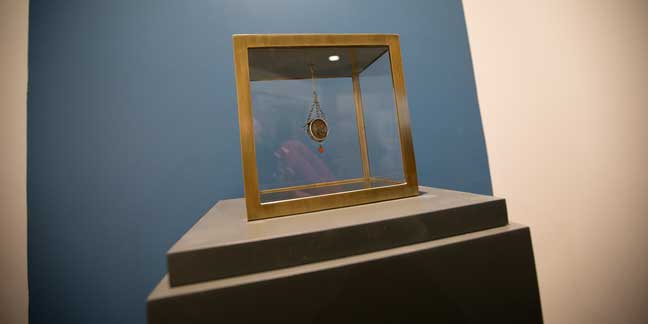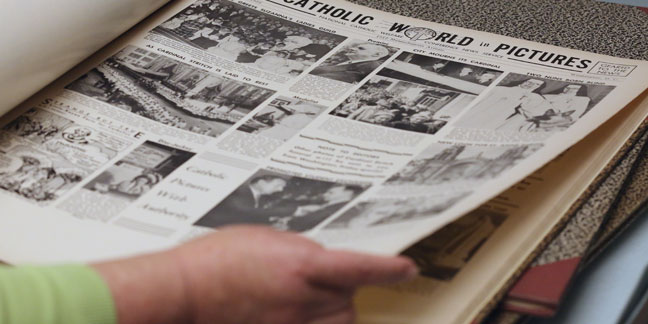 WASHINGTON, D.C. — A new exhibit featuring artifacts revolving around St. Thomas More has opened at the St. John Paul II National Shrine in Washington.
WASHINGTON, D.C. — A new exhibit featuring artifacts revolving around St. Thomas More has opened at the St. John Paul II National Shrine in Washington.
Titled "God's Servant First: The Life and Legacy of Thomas More," the exhibit runs through March 31. The title comes from what are believed to be More's last words before going to the chopping block where he was beheaded: "I die the king's good servant, and God's servant first."
Nearly all of the 60 or so items in the exhibit come from Stonyhurst College in England, according to Jan Graffius, the curator of collections at Stonyhurst, a Jesuit institution. The Knights of Columbus and Stonyhurst's Christian Heritage Center organized the exhibit and are its sponsors.
To be able to have so many artifacts is remarkable, Graffius told Catholic News Service Sept. 15, the day before the exhibit opened, as she and her team were putting the finishing touches on the exhibit. King Henry VIII, who had St. Thomas More imprisoned in the Tower of London for more than a year before his execution, and subsequent monarchs had made Roman Catholicism virtually illegal and had all traces of Catholicism wiped out.
St. Thomas More, a lawyer and the first layman to serve as chancellor of England, had balked at helping Henry VIII obtain an annulment so he could marry Anne Boleyn in hopes of bearing him a son to be heir to the throne. After the pope denied the annulment, Henry declared himself head of the church in England, conferring upon himself the power to divorce and marry whomever he pleased.
More, who also was a husband and father, resigned his position as chancellor to the throne to avoid being forced to acknowledge Henry VIII as head of the church. But after a law was passed requiring acknowledgment by all Britons of Henry's authority, More refused to sign a document stating as such. He was ultimately imprisoned, convicted of a capital treason with the help of perjured testimony, and beheaded. He has since been seen as a champion of conscience rights.
The luckless first wife of Henry VIII, Catherine of Aragon, spent her last days before her own death, possibly from poisoning, embroidering grapes onto a chasuble. That chasuble is in the exhibit.
Anne Boleyn wasn't all that lucky, either. After bearing a daughter -- Elizabeth I -- and later miscarrying, she fell into Henry's disfavor, was imprisoned on trumped-up charges of adultery, incest and treason, was herself beheaded 11 months after Thomas More, and buried not far from him, Graffius said.
Two relics in the exhibit made their way to the United States a few months ahead of the rest of the artifacts. One is a jawbone fragment of St. Thomas More; the other is a ring worn by St. John Fisher, who was also martyred under Henry VIII. Both were on exhibit during the U.S. bishops' "Fortnight for Freedom" activities in June and July.
The anti-Catholic laws imposed by Henry VIII stayed on the books in England for nearly three centuries until they were repealed in 1829. In 1886, St. Thomas More was beatified. In 1935, both he and St. John Fisher, who had been executed a few months before More, were both canonized. St. Thomas More was added to the Anglican calendar of saints in 1980.
Because of the anti-Catholic laws, Graffius said, Catholic parents had to sneak their children out of the country, sometimes under false identities, so they could receive a Catholic education. One of those schools was in the Spanish Netherlands -- mostly modern-day Belgium and Luxembourg -- and was the forerunner to Stonyhurst College.
St. Thomas More was part of the martyrology proclaimed every day at the school. The exhibit includes a schoolbook used by two brothers who eventually made their way to the United States. On one page of the book, an illustration of two men was defaced when one of the students sketched the men as smoking pipes. To this day, she added, nobody knows whether the pipes were added by John Carroll, the first Catholic archbishop in the United States, or his cousin Charles Carroll, the only Catholic signer of the Declaration of Independence.
In 2000, St. John Paul II made St. Thomas More, who had already been the patron saint of lawyers, the patron saint of statesman and politicians. The pontiff said his life and martyrdom offered a testimony that "spans the centuries" and "speaks to people everywhere of the inalienable dignity of the human conscience."
Patrick Kelly, the shrine's executive director, said in a statement that St. Thomas More's example "remains thoroughly modern."
"He is an eloquent example of courageous Christian discipleship, and it is our hope that this exhibit will inspire others to imitate his virtues and his extraordinary fidelity to God and to a well-formed conscience," Kelly added.
The exhibit comes during the golden anniversary of the 1966 film biography of St. Thomas More, "A Man for All Seasons." Recently restored with a new Technicolor print, "A Man for All Seasons" -- based on the stage play of the same name -- grossed the fifth-best box office numbers of the year, a stunning accomplishment given that it wasn't released until Dec. 12 that year and the weightiness of its subject matter.
The movie was nominated for eight Oscars and won six, including Best Picture, Best Director for Fred Zinneman and Best Actor for Paul Scofield as Thomas More. It also won five British Academy Film Awards and four Golden Globes, as well as a Best Actor award for Scofield at the Moscow International Film Festival.
— Mark Pattison, Catholic News Service
 WASHINGTON, D.C. — Only pack rats would save copies of old newspapers. Or so you would think.
WASHINGTON, D.C. — Only pack rats would save copies of old newspapers. Or so you would think.
But a consortium of librarians and archivists are preserving the Catholic news from the last century.
As newspapers age, their pages get more brittle and fragile. And outdated technologies such as microfilm and microfiche keep those newspapers from being readily accessible unless you live near a big downtown library or a university that still has the machines needed to read that data.
Many Catholic newspapers, unlike their secular daily brethren, were not kept, maintained and preserved with the same level of passion, save for some diocesan archives.
To correct this situation, the Catholic Research Resources Alliance has undertaken a project to digitize nearly a dozen of the United States’ top Catholic newspapers of regional and national importance – the print runs of which, for some of them, go back for more than a century.
“Creating a Catholic news archive and digital aggregation for Catholic newspapers is something that scholars are very interested in,” said Jennifer Younger, executive director of the alliance, known as CRRA.
“We mark the beginning (of the project) in 2011, when we brought together a newspaper committee: ‘If we’re going to digitize something, what would be most useful?’ Newspapers rose right to the top. Which newspapers? We had to figure out which newspapers existed, which ones were being held (by libraries), which ones weren’t being held,” she said.
The committee came up with a list of more than 800 Catholic publications from the United States alone, and another 200-plus in Canada.
Eleven newspapers the digitization project has begun with represent some of the largest dioceses in the nation: Catholic New York of the Archdiocese of New York; the Catholic Standard and Times of the Archdiocese of Philadelphia; Catholic San Francisco; the Clarion Herald of the Archdiocese of New Orleans; the Florida Catholic of the Archdiocese of Miami; the St. Louis Review; the Pittsburgh Catholic; and the Catholic Transcript of the Archdiocese of Hartford, Conn.
A 12th newspaper recently added to the list is the Catholic Worker, which since its founding in the 1930s is still a penny a copy, as the front-page banner says.
For a national perspective, the National Catholic Reporter and 65 years’ worth of newsfeeds starting in 1920 from what is now called Catholic News Service will be digitized. CNS’ predecessor was NCWC, for National Catholic Welfare Council. In addition, an NCWC/CNS feature called “Catholic World in Pictures” will be digitized too.
The digitized material will be made freely available through the CRRA-developed Catholic News Archive, www.thecatholicnewsarchive.org.
Digitization is the new normal, according to Tim Meagher, an associate professor of history at The Catholic University of America, Washington, and an archivist who runs the Center for American Catholic History.
“Everything is, as much as possible, going into digital format,” Meagher said. “In some ways, even if the paper exists in print, its use will be less if it is not digitized.”
Some of the largest U.S. dailies, including the New York Times, Washington Post and Chicago Tribune, have been digitized, he said. “It’s a tremendous asset,” Meagher added. “Suddenly you’re on the radar screen, easy to access, easy to get to.”
Of Catholic papers, he said, “We would love to be able to digitize every one. We may not be able to digitize all of them, we may not be able to digitize all years. But to begin is an important thing.”
“We have set very high standards. When we do our digitization, we never have to do it again,” said Patricia Lawton, CRRA’s director of digital initiatives. “We’re getting the best imaging we possibly can. Microfilm or print, you want a good image. That is the basis of everything that you’re going to do,” allowing the user to employ more robust search capabilities. “We based all our research on the Library of Congress (standards) and even upped the standards a bit,” Lawton noted.
Archivists also are working with those libraries and diocesan archives holding newspaper collections to preserve them, and to provide multiple backups for the digital information being created.
— Mark Pattison, Catholic News Service
More online
Check out the complete digital archives of the Catholic News Herald, from its founding in 1991 to present

